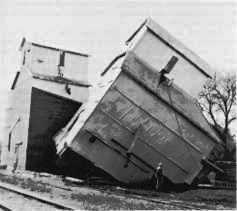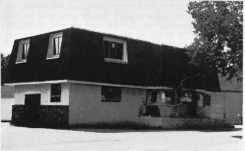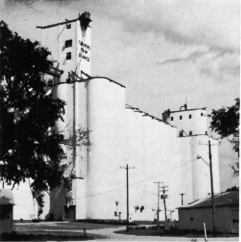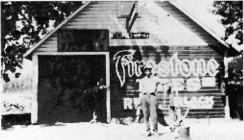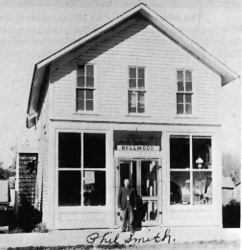|
|
Bellwood Co-operative
Bank
Gazette-June 12, 1934
A meeting was held for the
purpose of discussing plans for organizing a Cooperative
Bank in Bellwood. There were a sufficient number of signers
and a charter will be drawn up.
Bellwood Cooperative Credit Association's
first officers were the following: Alfred Peck, President;
John J. Kirchner, and H. L. Stemper, Supervising Committee;
O. A. Brandenburgh, Secretary-Treasurer.
From this beginning in 1934, the Bellwood
Co-op Credit Association has developed into a full-service
banking facility with checking, insurance, saving and loan
services, with policy and programs of the bank developed by
the customers. Calvin Sorensen preceded Paul Chatelain as
Secretary-Treasurer.
Bellwood Co-op Service
Center
After months of casual conversation by
a group of farsighted individuals who believed in the future
of their community and the need to join forces to provide a
more economical means of procuring their fuels and other
needs, a formal organizational meeting to establish
Consumers Co-op Oil was held Feb. 21, 1927.
Selected as temporary chairman was W. J.
Puetz, ultimately named as the first board president, a post
he was to hold until 1944. Other individuals on the first
board of the fledgling company were Rudolph Schmid, vice
president; J. W. Kreizinger, secretary; I. E. DeFord,
treasurer; and L. B. Wagner.
The group solicited funds from area
farmers, primarily, and established a company with 158
shareholders. The first board of directors managed all
aspects of the business from allowing bills to be paid and
negotiating for land for future building to its first
official act after organization -- ordering a car load of
fuel.
J. J. Kirchner was chosen as the first
manager, at a salary of $50.00 per month, after the company
was organized. He was awarded $40.00 for the month prior to
organization.
The young company showed sales of $21,896
in its first year of operation and the directors voted a 12
percent patronage dividend with seven percent to be paid on
stock. Net savings for the first year's efforts were
$3,768.
As with most industries, the Co-op had its
ups and downs financially, the lowest net savings having
occurred in 1934 with a dip to $1,710. However, throughout
the years, the company has shown a usually steady gain and
in 1979 reported net savings of $101,000, on sales of
$2,300,000. Members equity in the company rose from the less
than $10,000 upon organization to $765,000 at the close of
the 1978-79 fiscal year.
During the early years the Oil Company was
affiliated with Skelly and Quaker State, purchasing the
majority of its gasolines, diesels and other related items
from them. In 1939, the Company finalized negotiations with
Consumers Cooperative Association in Kansas City (now known
as Farmland Industries), an affiliation which remains in
effect today.
Company facilities were constructed as
needs arose with fuels storage being the first concern and
ultimately the service station. The present station was
built by Walter Hosher who had been awarded the contract for
$.75 per hour. The building was ready for occupancy in
1947.
|
|

The Oil Company's fuels storage area
was moved to its present location south of Bellwood in 1953
following the most disastrous event of its existence, namely
a $7500.00 fire which destroyed the original plant, a 1949
gas truck and injured driver Richard Didier. The blaze was
set off by a spark which caused an explosion throwing Didier
from the small office.
In 1954 the Oil Company, began its first
sales of fertilizer and showed sales of $7,672. Distillate
driver Didier hauled the various products from a site in
Columbus. As this looked like a new beginning, the directors
agreed to establish an anhydrous plant in 1955. Cost of the
anhydrous at that time was nine and a half cents per pound,
actual.
From the mid-fifties, the Company, known
as Bellwood Co-op Service Center after 1977, began its plan
for expansion into the fertilizer business, while still
maintaining the service station, propane and fuels end of
operation. Propane plant was established in 1965.
During 1973-74 the Co-op erected massive
storage for dry and liquid materials on the northeast edge
of Bellwood, along the railroad right-of-way. The 1970s
closed with the first loads of dry and liquid fertilizer
being pulled from satellite plants located at Octavia and
seven miles west of Bellwood. Fertilizer sales had risen to
$1,000,000.
Perhaps the reason for success of the
Co-op has been the dedication of persons closely associated
with the business, namely directors and managers.
One of the first board officers, Rudolph
Schmid, later served as president and was recognized for 35
consecutive years on the board at his retirement.
Other board presidents have been Leo
Janicek, Robert Trofholz, Don Semin, Ed Hobza and the
current president, Walter L. Mick, who is completing his
ninth year on the board.
Following J. J. Kirchner as manager were
Joe Kirchner in 1937; Oscar Pace in 1943; Otto J. Selzer,
Jr., in 1948; and Elmer J. Micek, in 1979. Selzer holds the
employment longevity record with 32 consecutive years,
including his years as manager.
Farmers Co-operative Grain
Co.
Many grain dealers have served the
Bellwood area since the early 1880's, some of which were:
Spelts & Klosterman, Central Graneries,
Nye-Schneider-Jenks, later becoming Nye-Schneider-Fowler,
Golden West, Holland, Morrissey Bros., F. E. Gage and the
Farmers Grain Co., which has been providing a market place
for the area farmers crops for 70
|
|

